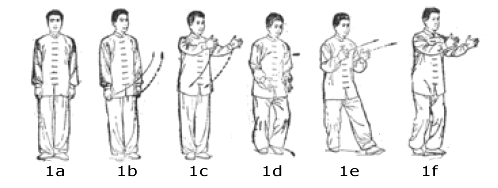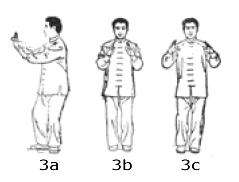1. Wu Ji Becomes Tai Ji (Wu Ji Bian Tai Ji) 无极变太极Name: Commencing Form (Qi Shi : 起式), Wu Ji then Tai Ji, Standing in Wuji and Opening Move, Commencing Form of Taiji (Taiji Qi Shi), A Study of Wu Ji and Tai Ji. 无极变太极 : Wu Ji Bian Tai Ji : Wu Ji Becomes Tai Chi.
Begin at position 1a, with the waist facing N12. Relax (Sung), clear the mind, calm the spirit, be present here and now. Stand at attention with the arms at the sides (1a). The heels are touching and the toes are pointed outwards slightly, so that the feet make a V shape (1a). The crown of the head is lifted. The shoulders are relaxed. Root and center oneself. This (1a) is the position of Wuji.

Description of movement sequence: Turn the right toe inward, and turn body towards NW11 (1a-1b). Raise the hands up with the fingers pointing down (1b). As as the hands move to about chest height (1b-1c) the fingers point forward (1c). Draw the hands in towards the body, and lower the hands to the Dan Tien level (1c-1d). Bend the knees slightly (1c). Lift both arms up, keeping them close to the body, to about chest height with the finders pointing forward (1d-1e). Shift the weight into the right leg (1d-1e) and step forward towards NW11 with the left foot, heel first (1d-1e) Draw the right toe forward until the right toe is next to and behind the left (1f). As the right leg moves forward, push both hands forward towards NW11 (1e-1f). The waist and chest face in the direction of NW11.
The movement sequence from 1d-1f, stepping forward with one leg and then following with the other leg is common in Sun Taijiquan. It is referred to as "Step and Follow Step" or "Follow Step." The first leg steps and the heel is placed first. The second leg steps with the toe. The knees are slightly bend. The torso is upright and poised. The back toe is placed so that it touches the ground next to and slightly behind the front foot, back toe near front heel. The knees are slightly bent.
Most authorities identify position 1a with "Commencing Form" and with Movement #1. Most authorities combine the movements 1b-1f with 2a-2e and call them all "Lazily Tying Clothes" (1b-2e), or Movement #2. I differ from the authorities about what constitutes movements #1 and #2.
I call positions 1a-1f, Movement #1, and give its name as "Wu Ji Becomes Tai Ji." In my opinion, position 1a represents Wu Ji: the empty state, the primordial fecund condition, that which cannot be named, the undifferentiated, Oneness, before the Big Bang, Zero, outside space and time, motionlessness, Wu. The body rises up and the hands circle up and down in positions 1b-1d, the typical opening move of raising the hands and lowering the hands of nearly all taijiquan forms, which represents: the opening, the differentiation into Yin and Yang, creation, emergence, the creation of complimentary forces, the essential beginning of space/time/being, Beginnings, the Grand Ultimate, the definitions of limits, the Tai Ji. The rising up and stepping forward and pushing forward (1d-1f) represent: the power of the universe, the five elements, the Bagua, the I Ching, complexity, evolution, the emergence of the ten-thousand things, will and intention, saying "Yes" to life, and the assertion of spirit. This is why I call this sequence (1a-1f) of movements "Wu Ji Becomes Tai Ji." I also think that this opening movement, Movement #1, Wu Ji Becomes Tai Ji, coordinates and blends well with the final two movements of the 73 Form, that is, Movement #72, Uniting Yin and Yang, and Movement #73, Returning to Wu Ji. This is how I interpret this sequence of moves, and this lifts my spirits. I find it charming and meaningful. Knowing of Sun Lu Tang''''s penchant for Taoist philosophy, I think he might smile and have some sympathy with my fanciful ideas. If you like, of course, you may also think that these movements (1b-1f) represent or are called or are part of "Lazily Tying the Clothes" (1b-1e). Indeed, I am probably just lazily trying to tie some ideas around the body of a dance.
"Creation and reversion are both expressed in Taiji quan forms. Practitioners begin by standing motionless and being free of thought [1a], then move in symbolic separation of yin and yang, lifting the hands as yang energy rises to create Heaven [1b] and lowering them [1d] as yin energy sinks to create Earth. Like the creation of the myriad beings, the movements transform from posture to posture without pause. In the end, the hands drop and the feet come together [72b]. Practitioners find stillness and return to formlessness [73c]."
- Daoist Body Cultivation, Edited by Livia Kohn, 2006, p. 195.
2. Lazily Tying Clothes (Lan Zha Yi) 懶扎衣 Name: Tuck in Robes (Lan Zha Yi), Leisurely Tying Clothes, Lazily Tying Back the Clothes, Lazily Tying Clothes : Lan Zha Yi : 懶扎衣.
Position 2a = 1f. Many authorities say that the movement sequence of 1b-2e is all part of Lazily Tying Clothes. However, other instances of Lazily Tying Clothes in the 73 Form, namely Movements 18, 26, and 45, all look rather like 2a-2e with the addition of drawing the hands down before striking with the fingers (26b-26d), then circling back and to the side and then striking forward with the palm along with a follow step (26d-26f) or (2c-2e).
3. Opening Hands (Kai Shou) 开手 Name: Open Hands (开手 : Kai Shou), Opening Hands.

From 3a = 2e, turn the body to the left, 90° counterclockwise, to bring the front of the body to face N12 (3b). Move both hands to the left and bring the hands in front of body at chest height (3a-3b). Turn the right foot on the heel until both feet are facing N12 (3a-3b). Fingers are pointing up (3b). Palms face each other (3b). The hands are relaxed and the fingers are gently spread apart, and the thumbs point towards one another and are held about 2 inches apart (3b). Exhale gently through the nose while moving from 3a to 3b. The hands move from the side position (3a) until the hands are about shoulder width apart (3b), and then gently move towards each other (3b) until both hands hands are separated by about 6-8 inches or about the width of your head (3b). From position 3b, as you breathe in through the nose, gently and slowly move the hands apart (3b-3c). Keep the fingers pointing up and palms facing each other. Stop opening the hands when they are about shoulder width apart (3c). Keep your body standing tall, back straight. The knees are slightly bent. At position 3c, the waist is facing N12.
Moving from 3b to 3c is the act of "Opening Hands" (Kai Shou) and is an essential qigong move of Sun Taijiquan, and part of the essential transitional move between postures of the Sun Taijiquan Form.
Sun Lu Tang says, "The hands feel as if they are holding on to a balloon, and as the air in the balloon increases, the hands are slowly moved apart. The two thumbs are about an inch or two away from the chest. Move the hands apart until the tiger''''s mouth [i.e, the are from the inside tip of the index finger to the inside tip of the thumb] of each hand are in front of the shoulders, at shoulder height. The five fingers are separated. Pause for a moment." - A Study of Taijiquan, 1924, 2003, p. 81.
In photos of Sun Lu Tang in position 3e, his left heel is slightly raised; but other current 73 Form instructors have you keep both feet flat on the floor in Opening Hands. Instructors vary in how much distance to keep between the feet when doing Opening and Closing Hands. Sun Lu Tang keeps his feet close together (3b), while other instructors place the feet a comfortable distance apart (6" to 15").
Breathe in through the nose when opening hands. Stand up straight. Hold the head erect (3b-3c). Shoulders are slightly rounded inward. Knees are slightly bent. Relax and settle; find the central equilibrium.
4. Closing Hands (He Shou) 合手Name: Close Hands (合手 : He Shou), Closing Hands, Draw Hands Together.
Move the hands from about shoulder width apart (4a = 3e) to about 6-8 inches apart (4b). This movement is called Closing Hands (He Shou). Gently breathe out through the nose when closing hands (4a-4b). Stand up straight. Hold the head erect. Shoulders are slightly rounded inward. Knees are slightly bent. Relax and settle; find the central equilibrium.
At position 4b, the waist is facing N12.
Moving from 4a to 4b is the act of "Closing Hands" (He Shou) and is the essential qigong move of Sun Taijiquan, and part of the essential transitional move between postures of the Sun Taijiquan Form.
In photos of Sun Lu Tang in position 4b, his left heel is slightly raised; but other current 73 Form instructors have you keep both feet flat on the floor in Closing Hands.
Sun Lu Tang says, "Lift the right toes off the ground and, pivoting on the right heel like an axle, turn your body to the left. As you turn, turn your right toes inward until they point directly forward. This turning movement must be done with the qi united, in one smooth movement without pauses or breaks. The jing must be balanced; do not use brute force. As you turn, the two hands maintain the position as if holding a balloon, as they close back together. The hands close until the thumbs are about an inch apart. The palms of the hands are empty, and they maintain the position as if holding a ball. The legs are bent. The right sole is placed flat on the ground and the left heel is lifted, with the ball of the foot on the ground. There must not be the slightest use of force in the entire body."
- A Study of Taijiquan, 1924, 2003, p. 82.
The Opening Hands (Kai Shou) and Closing Hands (He Shou) movements are repeated 9 times in the 73 Form at # 3/4, 8/9, 15/16, 19/20, 27/28, 42/43, 46/47, 51/52, and 63/64.
"Sun Shi Tai Ji has a very specific figure; Kai He (to open - to close) which is found neither in other forms of Tai Ji, nor in Ba Gua or Xing Yi. This Kai He appears with each connection and transition. It makes it possible to control and adjust breathing and to accumulate the Shi (energy potential) in order to prepare for the next change."
- Master Bob Melia, Sun Shi Tai Chi
5. Single Whip Left (Dan Bian Zou) 单鞭左 Name: Single Whip Left (单鞭左 : Zou Dan Bian), Single Whip to the Left Side (Dan Bian Zhou), Single Whip.
From position 4b = 5a, step out with left leg towards W9 (5a-5b). Open both of the the arms to sides, right hand towards E3 and left hand towards W9, with the fingers of both hands pointing upward (5a-5b). Look first at the left hand, then at the right hand (5b). Both arms are extended at about shoulder height (5b). End in 5b with left leg bent with 70% of weight in left left, in a left side bow stance. Gaze at the right hand (5b). At position 5b, the waist is facing N12.
In the Sun Style of Taijiquan, Single Whip always follows Opening Hands and Closing Hands (i.e., Movements 5, 21, 29, 48,53, and 65). In the Yang Style of Taijiquan, the Single Whip always follows the movement called "Grasping the Sparrow''''s Tail."



